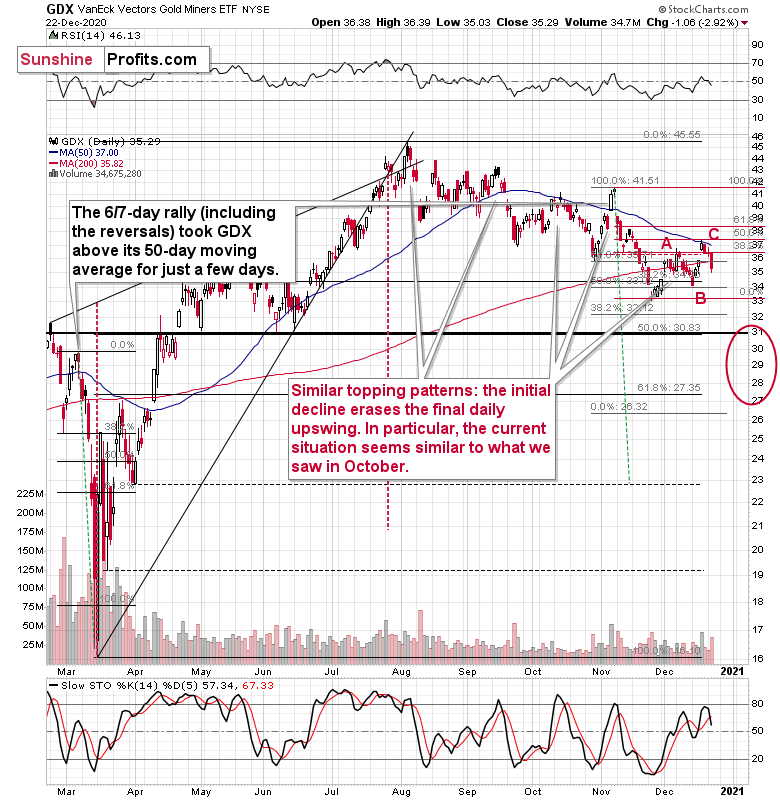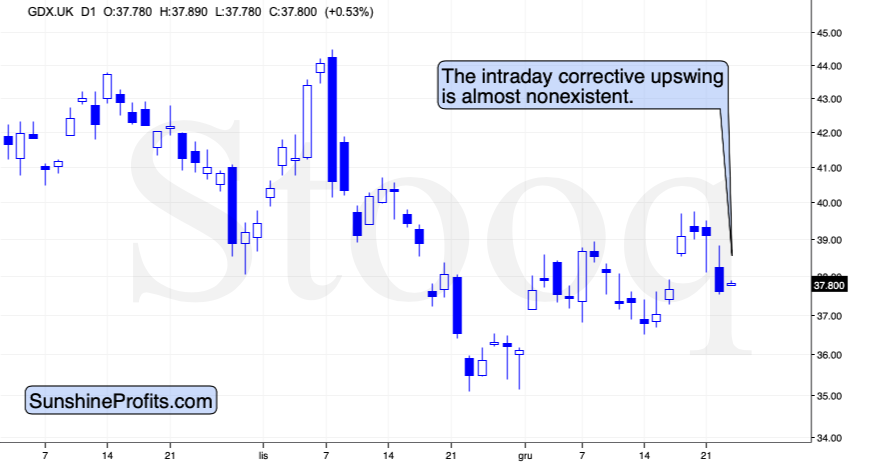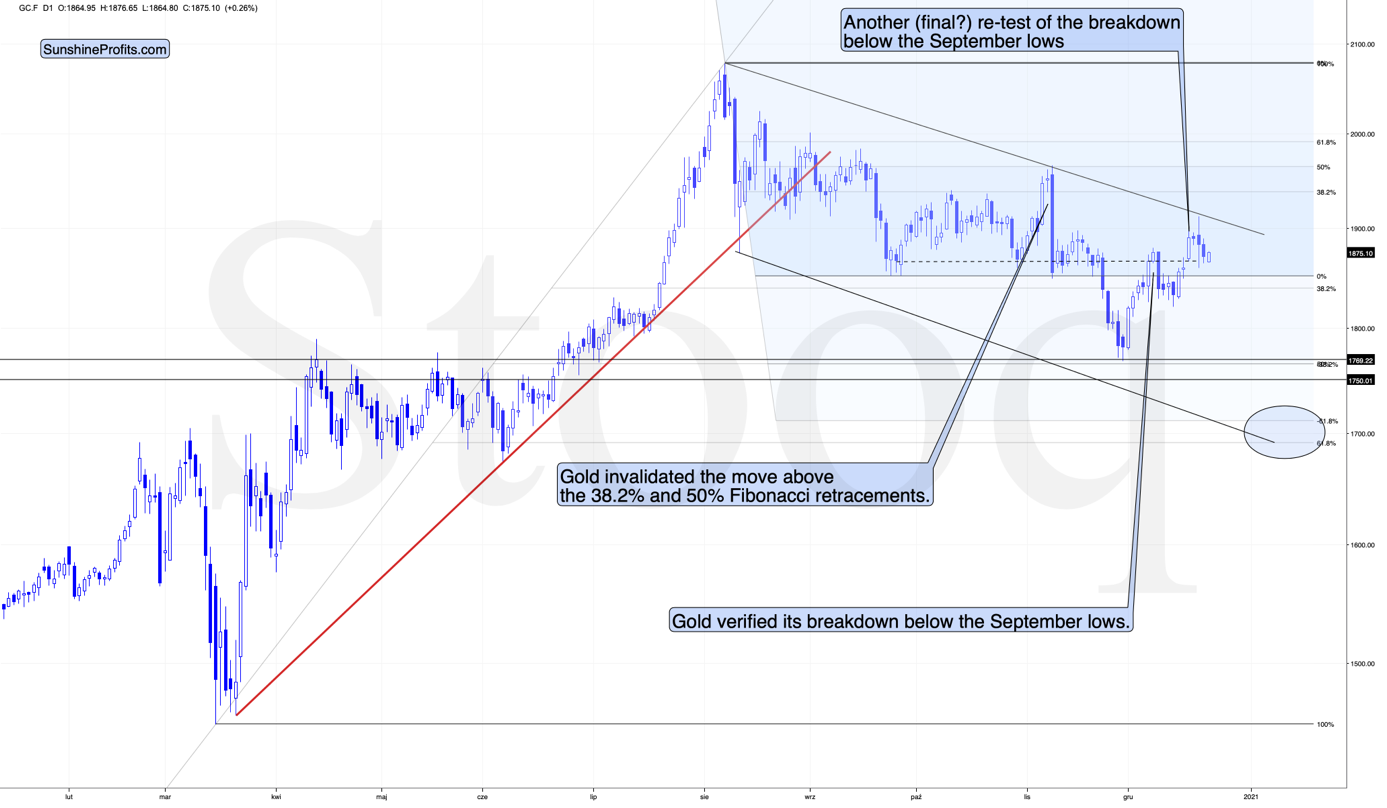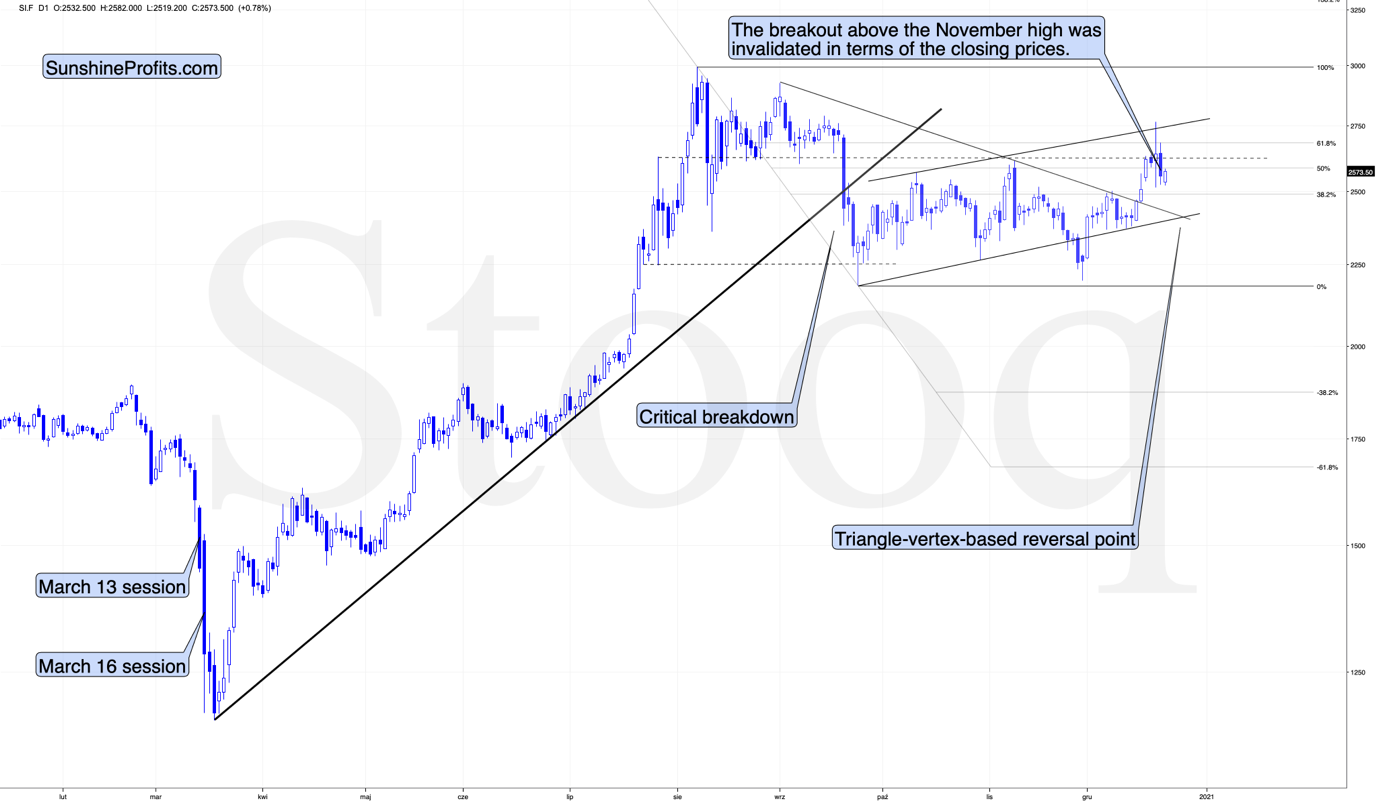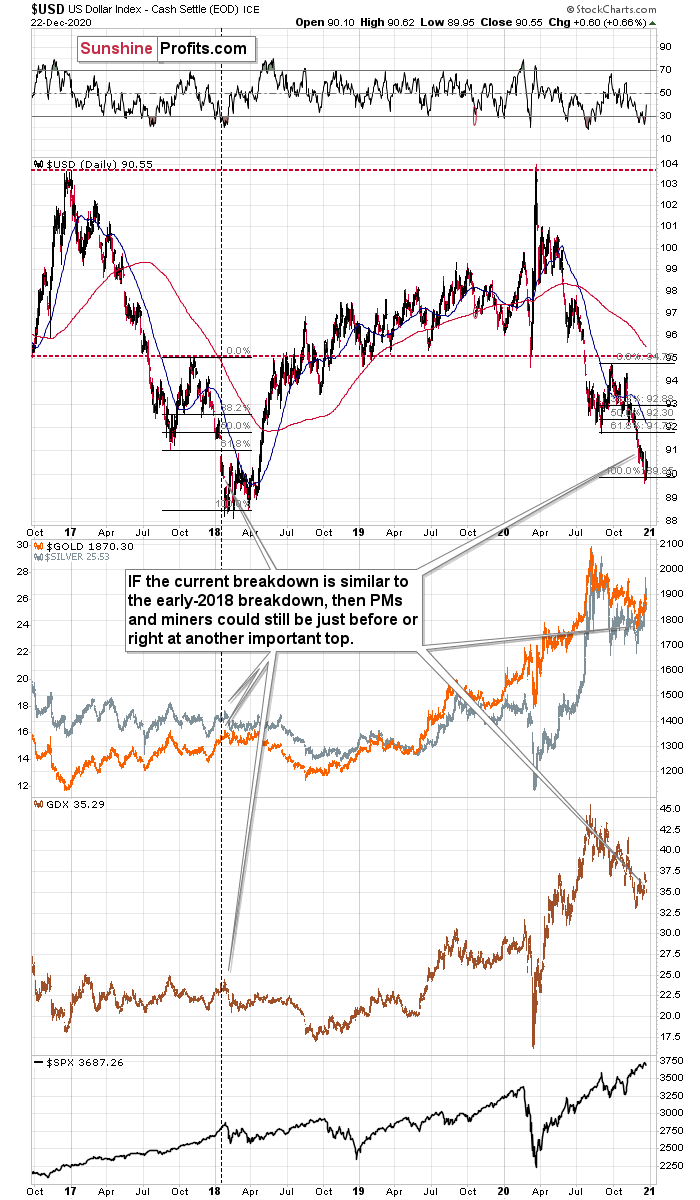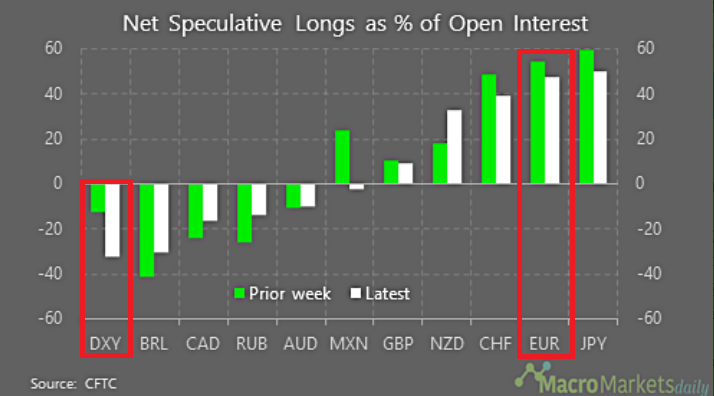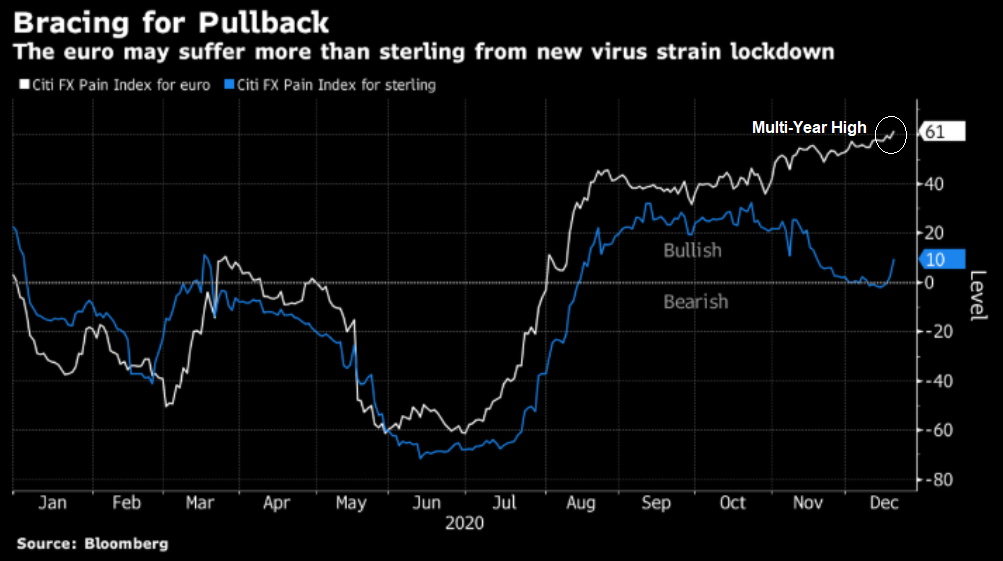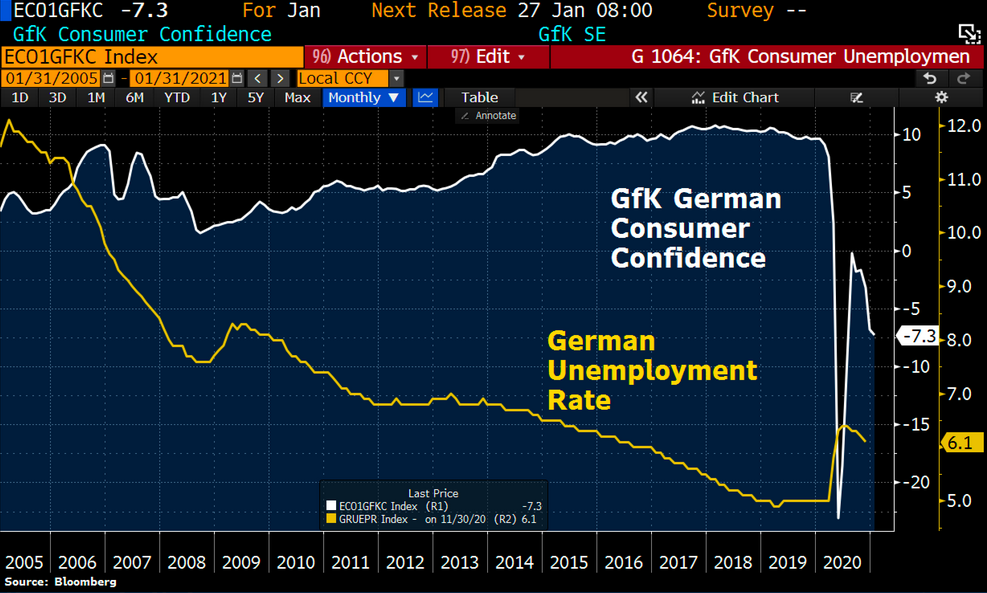Briefly: in our opinion, full (300% of the regular position size) speculative short positions in mining stocks are justified from the risk/reward point of view at the moment of publishing this Alert.
Yesterday’s trading confirmed my previous comments – gold, silver, and mining stocks declined. They all moved back up in today’s pre-market trading, but the relative performance of these markets have also confirmed the bearish outlook. Let’s take a look at the details, starting with gold stocks.
The GDX ETF declined visibly yesterday and it did so on volume that was a bit below the volume on which the GDX topped at its 50-day moving average last week. At the same time, we saw a new sell signal in the Stochastic indicator. This is exactly what we saw in early November, before the approximately $8 decline. An $8 decline from the recent top would imply a move to about $31, which is the upper border of the target area that I’ve been featuring for some time. And since history tends to repeat itself to a considerable degree, the above became more likely based on the above analogy.
In today’s trading that’s taking place on the London Stock Exchange, the GDX is barely up. It hasn’t corrected almost anything from yesterday’s decline, even though gold is up more visibly. This is bearish.
If we consider how much gold and the GDX changed this week, it’s clear that miners continue to underperform gold, magnifying it’s declines and mostly ignoring its upswings.
Why does it matter? Because one of the key gold trading tips is that gold stocks tend to outperform gold in the early stages of big upswings, and they tend to underperform gold in the early stages of big downswings. Gold miners’ relative performance has been providing us with bearish indications for weeks, even during rallies. The implications are bearish. It seems that we will see a major decline before seeing a breakout to new highs in gold.
Silver is behaving relatively normally right now, but it was particularly strong relative to gold in the previous days – the opposite of what we saw in the miners.
The interesting fact that we would like to emphasize today is that yesterday silver closed the day below the highest close of November, thus invalidating the breakout above it. That’s a bearish phenomenon.
Meanwhile, the USD Index is after a short-term breakout.
So far, we saw just a single daily close above the declining resistance line, so it’s far from being confirmed. Still, today’s pre-market decline didn’t take the USDX back below the above-mentioned resistance, so the implications are still much more bullish for the short-term than they were on the previous days. This is bearish for the precious metals market and my previous comments on the 2018 analogy remain up-to-date:
This is especially the case if the USD Index is about to move higher, and this does seem to be the case, as it moved back above my previous Fibonacci-extension based target.
When the same thing happened in 2018, it meant that the decline was practically over for the USDX, and that the top was in for the precious metals sector.
So, it appears that after bouncing off my initial downside target (89.8 – 90) on Thursday (Dec. 17), the USDX seems poised for a resurgence.
Yesterday (Dec. 22), I warned that extreme over positioning (with too many traders shorting the U.S. dollar) could lead to a massive short-covering rally (where investors buy the U.S. dollar to exit their bearish trades). And yesterday? We may have just witnessed the opening act.
The USDX had its best day since September 8 (when comparing one-day percentage increases). And like a snowball becoming an avalanche, the USDX’s potential rally could be fast and furious.
The latest release from the Commodity Futures Trading Commission (CFTC) shows that speculative traders increased their U.S. dollar short positions (versus the prior week), while roughly maintaining their euro longs.
Please see the chart below:
In addition, just before news broke that COVID-19 had potentially mutated (which led to new lockdown measures in the U.K.), Citigroup’s FX PAIN index showed that bullish bets on the euro hit multi-year highs (The index measures overcrowded positioning, with values > 100 representing bullish optimism.)
Please see below:
And why is the euro so important here?
Because traders piled into the euro just as German consumer confidence headed vertically lower. Yesterday’s reading (– 7.3) marked the third-straight month of German consumer confidence declines and occurred even as the German unemployment rate fell (consumer confidence should move in the opposite direction of the unemployment rate).
And why is Germany so important here?
Because the country is Europe’s largest economy, contributing nearly €3.5 trillion to the Eurozone GDP (roughly 1.37x the U.K. and 1.42x France, the next two largest contributors). Thus, if the German economy slows, it will likely drag down the rest of Europe (and EUR/USD) with it.
Remember, movement in the euro accounts for more than half of the movement in the USDX. As a weighted-average index, the USDX derives its value relative to the euro (57.6%), Japanese Yen (13.6%), Canadian dollar (9.1%), British pound (11.9%), Swedish Krona (4.2%) and the Swiss Franc (3.6%).
Thus, if EUR/USD declines, the weight of the move will likely propel the USDX higher.
Options update
Like I predicted on Friday (Dec. 18), options activity across the GDX indicated trouble beneath the surface.
And yesterday, that trouble caught up with investors and led the GDX 2.92% lower (the ETF closed the day at $35.29).
The plunge coincided with call and put option activity becoming hysterical (Remember, call options profit when the GDX rises in price and put options profit when the GDX declines in price.)
Please see the call option activity below (Dec. 31 expiry):
Source: Yahoo! Finance
And the put option activity (Dec. 31 expiry):
Source: Yahoo! Finance
As you can see, call option prices declined by more than 50% yesterday, as bulls feared that gold (and the miners) likely topped. In contrast, put option prices exploded on Tuesday (Dec. 22), with the cost of insurance more than doubling for protection below $35.00.
The frantic activity supports the following argument I’ve been making: gold’s weakness relative to the USDX and the miner’s weakness relative to gold was a bearish precursor to what we’re seeing now. The technicals provided an early indication of gold’s (and the miners’) future price action, and now, it looks like investors are starting to realize it themselves.
Overview of the Upcoming Decline
- As far as the current overview of the upcoming decline is concerned, I think it has already begun.
- During the final part of the slide (which could end within the next 1-5 weeks or so), I expect silver to decline more than miners. That would align with how the markets initially reacted to the Covid-19 threat.
- The impact of all the new rounds of money printing in the U.S. and Europe on the precious metals prices is incredibly positive in the long run, which does not make the short-term decline improbable. Markets can and will get ahead of themselves and decline afterward – sometimes very profoundly – before continuing with their upward climb.
- The plan is to exit the current short positions in miners after they decline far and fast, but at the same time, silver drops just “significantly” (we expect this to happen in 0 – 3 weeks ). In other words, the decline in silver should be severe, but the decline in the miners should look “ridiculous”. That’s what we did in March when we bought practically right at the bottom . It is a soft, but simultaneously broad instruction, so additional confirmations are necessary.
- I expect this confirmation to come from gold, reaching about $1,700 - $1,750 . If – at the same time – gold moves to about $1,700 - $1,750 and miners are already after a ridiculously big drop (say, to $31 - $32 in the GDX ETF – or lower), we will probably exit the short positions in the miners and at the same time enter short positions in silver. However, it could also be the case that we’ll wait for a rebound before re-entering short position in silver – it’s too early to say at this time. It’s also possible that we’ll enter very quick long positions between those short positions.
- The precious metals market's final bottom is likely to take shape when gold shows significant strength relative to the USD Index . It could take the form of a gold’s rally or a bullish reversal, despite the ongoing USD Index rally.
Summary
While Christmas came early for the precious metals last week, the holiday cheer isn’t likely to last very long. Despite doing its best Santa Clause impersonation, silver’s gift-giving isn’t rubbing off on gold or the gold miners. And given its relative outperformance, it’s most likely only a matter of time before silver’s sleigh crashes.
The divergent price action signals that the next move lower in the precious metals market is already underway. It will likely take another 1-5 weeks to play out (or perhaps even longer), with gold falling to or below $1,700 and with a substantial decline in silver (downside target is unclear) and miners ($1,700 in gold is likely to correspond to about $31 in GDX).
Remember, last week’s upswing is a relatively normal bounce within a bigger decline. And this corrective upswing might have already ended.
Despite a recent decline, it seems that the USD Index is going to move higher in the following months and weeks, in turn causing gold to decline. At some point gold is likely to stop responding to dollar’s bearish indications, and based on the above analysis, it seems that we might expect this to take place in December.
Naturally, everyone's trading is their responsibility. But in our opinion, if there ever was a time to either enter a short position in the miners or increase its size if it was not already sizable, it's now. We made money on the March decline, and on the March rebound, with another massive slide already underway.
After the sell-off (that takes gold to about $1,700 or lower), we expect the precious metals to rally significantly. The final decline might take as little as 1-5 weeks, so it's important to stay alert to any changes.
Most importantly, please stay healthy and safe. We made a lot of money on the March decline and the subsequent rebound (its initial part) price moves (and we'll likely earn much more in the following weeks and months), but you have to be healthy to enjoy the results.
Finally, on an administrative note, due to the Holiday season, there will be no regular Alerts posted on Thursday (Dec. 24) and Friday (Dec. 25). If anything major happens, we’ll send out a quick message to you anyway.
As always, we'll keep you - our subscribers - informed.
To summarize:
Trading capital (supplementary part of the portfolio; our opinion): Full speculative short positions (300% of the full position) in mining stocks is justified from the risk to reward point of view with the following binding exit profit-take price levels:
Senior mining stocks (price levels for the GDX ETF): binding profit-take exit price: $32.02; stop-loss: none (the volatility is too big to justify a SL order in case of this particular trade); binding profit-take level for the DUST ETF: $28.73; stop-loss for the DUST ETF: none (the volatility is too big to justify a SL order in case of this particular trade)
Junior mining stocks (price levels for the GDXJ ETF): binding profit-take exit price: $42.72; stop-loss: none (the volatility is too big to justify a SL order in case of this particular trade); binding profit-take level for the JDST ETF: $21.22; stop-loss for the JDST ETF: none (the volatility is too big to justify a SL order in case of this particular trade)
For-your-information targets (our opinion; we continue to think that mining stocks are the preferred way of taking advantage of the upcoming price move, but if for whatever reason one wants / has to use silver or gold for this trade, we are providing the details anyway. In our view, silver has greater potential than gold does):
Silver futures downside profit-take exit price: unclear at this time - initially, it might be a good idea to exit, when gold moves to $1,703.
Gold futures downside profit-take exit price: $1,703
Long-term capital (core part of the portfolio; our opinion): No positions (in other words: cash
Insurance capital (core part of the portfolio; our opinion): Full position
Whether you already subscribed or not, we encourage you to find out how to make the most of our alerts and read our replies to the most common alert-and-gold-trading-related-questions.
Please note that we describe the situation for the day that the alert is posted in the trading section. In other words, if we are writing about a speculative position, it means that it is up-to-date on the day it was posted. We are also featuring the initial target prices to decide whether keeping a position on a given day is in tune with your approach (some moves are too small for medium-term traders, and some might appear too big for day-traders).
Additionally, you might want to read why our stop-loss orders are usually relatively far from the current price.
Please note that a full position doesn't mean using all of the capital for a given trade. You will find details on our thoughts on gold portfolio structuring in the Key Insights section on our website.
As a reminder - "initial target price" means exactly that - an "initial" one. It's not a price level at which we suggest closing positions. If this becomes the case (like it did in the previous trade), we will refer to these levels as levels of exit orders (exactly as we've done previously). Stop-loss levels, however, are naturally not "initial", but something that, in our opinion, might be entered as an order.
Since it is impossible to synchronize target prices and stop-loss levels for all the ETFs and ETNs with the main markets that we provide these levels for (gold, silver and mining stocks - the GDX ETF), the stop-loss levels and target prices for other ETNs and ETF (among other: UGL, GLL, AGQ, ZSL, NUGT, DUST, JNUG, JDST) are provided as supplementary, and not as "final". This means that if a stop-loss or a target level is reached for any of the "additional instruments" (GLL for instance), but not for the "main instrument" (gold in this case), we will view positions in both gold and GLL as still open and the stop-loss for GLL would have to be moved lower. On the other hand, if gold moves to a stop-loss level but GLL doesn't, then we will view both positions (in gold and GLL) as closed. In other words, since it's not possible to be 100% certain that each related instrument moves to a given level when the underlying instrument does, we can't provide levels that would be binding. The levels that we do provide are our best estimate of the levels that will correspond to the levels in the underlying assets, but it will be the underlying assets that one will need to focus on regarding the signs pointing to closing a given position or keeping it open. We might adjust the levels in the "additional instruments" without adjusting the levels in the "main instruments", which will simply mean that we have improved our estimation of these levels, not that we changed our outlook on the markets. We are already working on a tool that would update these levels daily for the most popular ETFs, ETNs and individual mining stocks.
Our preferred ways to invest in and to trade gold along with the reasoning can be found in the how to buy gold section. Furthermore, our preferred ETFs and ETNs can be found in our Gold & Silver ETF Ranking.
As a reminder, Gold & Silver Trading Alerts are posted before or on each trading day (we usually post them before the opening bell, but we don't promise doing that each day). If there's anything urgent, we will send you an additional small alert before posting the main one.
Thank you.
Przemyslaw Radomski, CFA
Founder, Editor-in-chief


